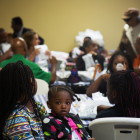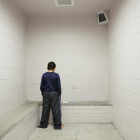
Few Harlem Youths at Planning Meeting Against Violence
|
“Today is a day for the residents of Grant and Manhattanville to tell the West Harlem Development Corporation what you need.”
Juvenile Justice Information Exchange (https://jjie.org/page/253/)

In late September, Torri was driving down the highway with her 11-year-old son Junior in the back seat when her phone started ringing.
It was the Hamilton County Sheriff’s deputy who worked at Junior’s middle school in Chattanooga, Tennessee. Deputy Arthur Richardson asked Torri where she was. She told him she was on the way to a family birthday dinner at LongHorn Steakhouse.
“He said, ‘Is Junior with you?’” Torri recalled.
Earlier that day, Junior had been accused by other students of making a threat against the school. When Torri had come to pick him up, she’d spoken with Richardson and with administrators, who’d told her he was allowed to return to class the next day. The principal had said she would carry out an investigation then. ProPublica and WPLN are using a nickname for Junior and not including Torri’s last name at the family’s request, to prevent him from being identifiable.
When Richardson called her in the car, Torri immediately felt uneasy. He didn’t say much before hanging up, and she thought about turning around to go home. But she kept driving. When they walked into the restaurant, Torri watched as Junior happily greeted his family.
Soon her phone rang again. It was the deputy. He said he was outside in the strip mall’s parking lot and needed to talk to Junior. Torri called Junior’s stepdad, Kevin Boyer, for extra support, putting him on speaker as she went outside to talk to Richardson. She left Junior with the family, wanting to protect her son for as long as she could ...

“Today is a day for the residents of Grant and Manhattanville to tell the West Harlem Development Corporation what you need.”

States face no real federal pressure to reduce racial and ethnic disparities in the juvenile justice system, a new report says.

We don’t always understand the world as well as we imagine, especially when it comes to the effects of public policy.This includes the crime rate and the impact of various interventions on it.

A collaboration with an unusual theater group over the last few months has lifted the spirits of a man on death row and given his life renewed purpose.

The Lucas County Juvenile Detention Center in Toledo, Ohio, has 125 beds. On Wednesday, only 17 of them were occupied, says Judge Denise Navarre Cubbon, of the Lucas County Juvenile Court.

How do you measure a youth’s success after they’ve gone through the juvenile justice system? Stellar grades and a job at a Fortune 500 company may set the bar a little high — so many states rely on recidivism rates, which track whether juveniles have repeated run-ins with the law.

The 10-year-old boy stands with his back to the camera and his hands in his pockets in a bare white cinderblock cell in the juvenile detention center.

It was early August, exactly two months after the largest raid in New York City history at the Grant and Manhattanville housing projects, when 20 people, mostly older folks, crammed into the Community Board 9 office in a tiny storefront in Harlem.